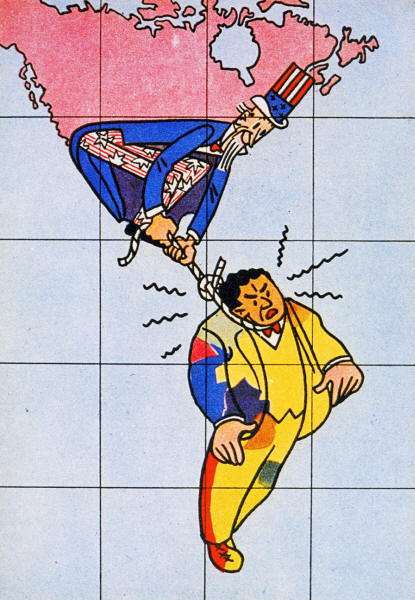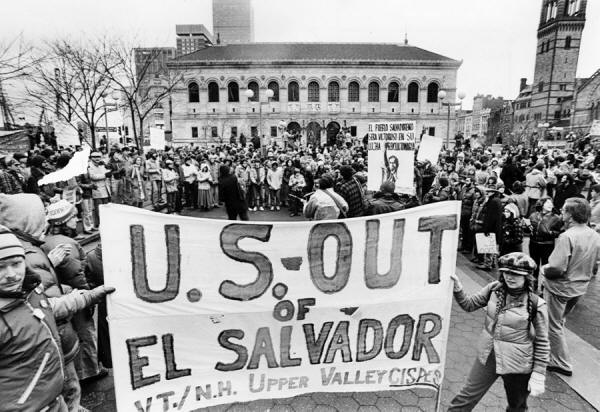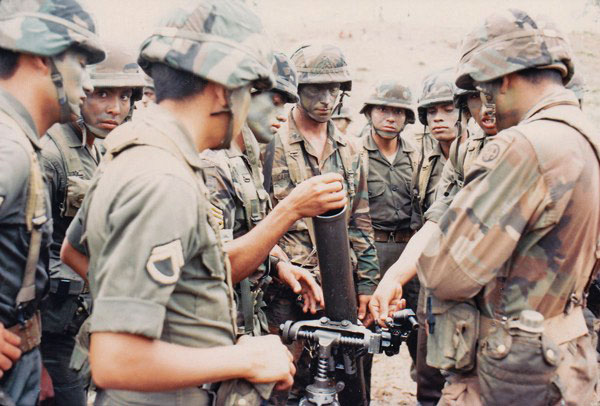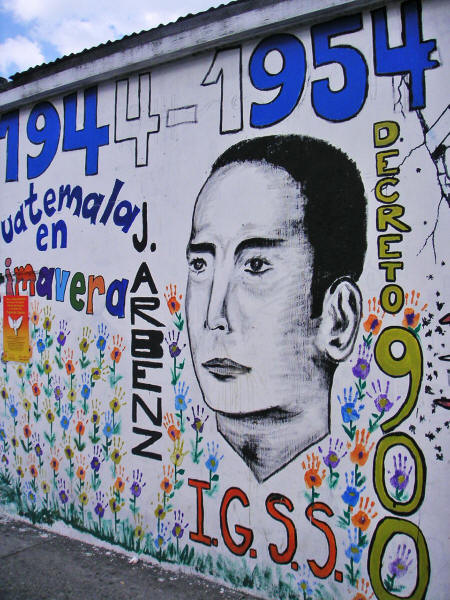|

by Mark Tseng-Putterman
June 20,
2018
from
Medium Website
Spanish version

The 1823 Monroe Doctrine
set the
stage for U.S. intervention
throughout Latin America.
Photo
by Michael Nicholson/Corbis via Getty
Those
seeking asylum today
inherited a
series of crises
that drove them
to the border...
A national spotlight now shines on the border between the United
States and Mexico, where heartbreaking images of Central American
children being separated from their parents and held in cages
demonstrate the consequences of the
Trump administration's
"zero-tolerance policy" on unauthorized entry into the country,
announced in May 2018.
Under intense
international scrutiny, Trump has now
signed an executive order that will keep families detained at
the border together, though it is unclear when the more than 2,300
children already separated from their guardians will be returned.
Trump has promised
that keeping families together will not prevent his administration
from maintaining "strong-very strong, borders," making it
abundantly clear that the crisis of mass detention and deportation
at the border and throughout the U.S. is far from over.
Meanwhile,
Democratic rhetoric of inclusion, integration, and opportunity has
failed to fundamentally question the logic of Republican calls for a
strong border and the nation's right to protect its sovereignty.
At the margins of
the mainstream discursive stalemate over immigration lies over a
century of historical U.S. intervention that politicians and pundits
on both sides of the aisle seem determined to silence.
Since
Theodore Roosevelt in 1904
declared the U.S.'s "right" to exercise an "international police
power" in Latin America, the U.S. has cut deep wounds throughout the
region, leaving scars that will last for generations to come.
This
history of intervention is inextricable from the contemporary
Central American crisis of internal and international displacement
and migration...
The liberal
rhetoric of inclusion and common humanity is insufficient:
we must
also acknowledge the role that a century of U.S.-backed military
coups, corporate plundering, and neoliberal sapping of resources has
played in the poverty, instability, and violence that now drives
people from,
-
Guatemala
-
El Salvador
-
Honduras,
...toward Mexico and
the United States.
For decades, U.S.
policies of military intervention and economic neoliberalism have
undermined democracy and stability in the region, creating vacuums
of power in which drug cartels and paramilitary alliances have
risen.
In the past fifteen years alone,
CAFTA-DR - a free trade
agreement between the U.S. and five Central American countries as
well as the Dominican Republic - has
restructured the region's economy and guaranteed economic
dependence on the United States through massive trade imbalances and
the influx of American agricultural and industrial goods that weaken
domestic industries.
Yet there are few
connections being drawn between the weakening of Central American
rural agricultural economies at the hands of CAFTA and the rise in
migration from the region in the years since.
In general, the U.S.
takes no responsibility for the conditions that drive Central
American migrants to the border.
U.S. empire thrives on amnesia.
The Trump administration cannot remember what it said last week, let
alone the actions of presidential administrations long gone that
sowed the seeds of today's immigration crisis.
There can be no
common-sense immigration "debate" that conveniently ignores the
history of U.S. intervention in Central America.
Insisting on
American values of inclusion and integration only bolsters the very
myth of
American 'exceptionalism,' a narrative that has erased this
nation's imperial pursuits for over a century.
As the British
immigrant rights refrain goes,
"We are here
because you were there."
The adage holds no
less true here and now.
It's time to insist that accepting Central
American refugees is not just a matter of morality or American
benevolence. Indeed, it might be better described as a matter of
reparations.
The following timeline compiles
numerous sources to lay out an incomplete history of U.S. military
and economic intervention in El Salvador, Honduras, and Guatemala
over the past century:

Anti-war marchers at Copley Square
on their way to Boston Common to protest
U.S. military involvement in El Salvador,
on March 21, 1981.
Photo by John Tlumacki
The Boston Globe via Getty
1932:
A peasant rebellion, led by Communist leader Farabundo Martí,
challenges the authority of the government. 10,000 to 40,000
communist rebels, many indigenous, are systematically murdered
by the regime of military leader Maximiliano Hernández Martínez,
the nation's acting president. The United States and Great
Britain, having bankrolled the nation's economy and owning the
majority of its export-oriented coffee plantations and railways,
send naval support to quell the rebellion.
1944:
Martínez is
ousted by a bloodless popular revolution led by students.
Within months, his party is reinstalled by a reactionary coup
led by his former chief of police, Osmín Aguirre y Salinas,
whose regime is legitimized by immediate
recognition from the United States.
1960:
A military-civilian junta promises free elections. President
Eisenhower withholds recognition, fearing a leftist turn. The
promise of democracy is broken when a right-wing countercoup
seizes power months later. Dr. Fabio Castillo, a former
president of the national university, would
tell Congress that this coup was openly facilitated by the
United States and that the U.S. had opposed the holding of free
elections.
1980–1992:
A civil war rages between the military-led government and the
leftist Farabundo Martí National Liberation Front (FMLN). The
Reagan administration, under its Cold War containment policy,
offers significant military assistance to the authoritarian
government, essentially running the war by 1983. The U.S.
military
trains key components of the Salvadoran forces, including
the Atlacatl Battalion, the "pride
of the United States military team in San Salvador." The
Atlacatl Battalion would go on to commit a civilian
massacre in the village of El Mozote in 1981, killing at
least 733 and as many as 1,000 unarmed civilians, including
women and children. An
estimated 80,000 are killed during the war, with the U.N.
estimating that 85 percent of civilian deaths were committed by
the Salvadoran military and death squads.
1984:
Despite the raging civil war funded by the Reagan
administration, a mere three percent of Salvadoran and
Guatemalan asylum cases in the U.S. are approved, as Reagan
officials
deny allegations of human rights violations in El Salvador
and Guatemala and designate asylum seekers as "economic
migrants." A religious sanctuary movement in the United States
defies the government by publicly sponsoring and sheltering
asylum seekers. Meanwhile, the U.S.
funnels $1.4 million to its favored political parties in El
Salvador's 1984 election.
1990:
Congress
passes legislation designating Salvadorans for Temporary
Protected Status. In 2018, President Trump would
end TPS status for the 200,000 Salvadorans living in the
United States.
2006:
El Salvador enters the
Dominican Republic-Central
America Free Trade Agreement (CAFTA-DR), a neoliberal
export-economy model that gives global multinationals increased
influence over domestic trade and regulatory protections.
Thousands of unionists, farmers, and informal economy workers
protest the free trade deal's implementation.
2014:
The U.S.
threatens to withhold almost $300 million worth of
Millennium Challenge Corporation (MCC) development aid unless El
Salvador ends any preferences for locally sourced corn and bean
seeds under its Family Agriculture Plan.
2015:
Under the tariff reduction model of CAFTA-DR,
all U.S. industrial and commercial goods enter El
Salvador
duty free, creating impossible conditions for domestic
industry to compete. As of 2016, the country had a
negative trade balance of $4.18 billion.

Honduran soldiers operate a mortar
for members of the U.S. Army 82nd Airborne Division
during a joint exercise, March 1988.
(Photo: Department of Defense, NARA)
1911:
American entrepreneur Samuel Zemurray partners with the deposed
Honduran President Manuel Bonilla and U.S. General Lee Christmas
to launch a
coup against President Miguel Dávila. After seizing several
northern Honduran ports, Bonilla wins the Honduran 1911
presidential election.
1912:
Bonilla
rewards his corporate U.S. backers with concessions that
grant natural resources and tax incentives to American
companies, including Vaccaro Bros. and Co. (now Dole Food
Company) and United Fruit Company (now Chiquita Brands
International). By 1914, U.S. banana interests would come to own
one million acres of the nation's best land - an ownership
frequently insured through the deployment of U.S. military
forces.
1975:
The United Fruit Company ( rebranded as the United Brands
Company)
pays $1.25 million to a Honduran official, and is accused of
bribing the government to support a reduction in banana export
taxes.
1980s:
In an attempt to curtail the influence of left-wing movements in
Central America, the Reagan administration stations thousands of
troops in Honduras to
train Contra right-wing rebels in their guerrilla war
against Nicaragua's Sandinistas. U.S. military aid reaches $77.5
million in 1984. Meanwhile, trade liberalization policies open
Honduras to the interests of global capital and disrupt
traditional forms of agriculture.
2005:
Honduras becomes the second country to enter CAFTA, the free
trade agreement with the U.S., leading to
protests from unions and local farmers who fear being
outcompeted by large-scale American producers. Rapidly, Honduras
goes from being a net agricultural exporter to a net importer,
leading to loss of jobs for small-scale farmers and increased
rural migration.
2009:
Left-leaning and democratically elected President Manuel Zelaya,
who pursued progressive policies such as raising the minimum
wage and subsidizing public transportation, is exiled in a
military coup. The coup is staged after Zelaya announces
intentions to hold a referendum on the replacement of the 1982
constitution, which had been written during the end of the reign
of U.S.-backed military dictator Policarpo Paz García. Honduran
General Romeo Vásquez Velásquez, a graduate of the U.S. Army
training program known as the School of the Americas (nicknamed
"School of Assassins"), leads the coup. The United States, under
Hillary Clinton's Department of State,
refuses to join international calls for the "immediate and
unconditional return" of Zelaya.
2017:
Honduras enters an electoral crisis as thousands of protesters
contest the results of the recent presidential election,
which many allege was rigged by the ruling party.

A present-day Guatemala City mural
memorializes deposed President Jacobo Árbenz
and his historic land reforms.
Credit: Soman via Wikimedia Commons
CC BY 2.5
1920:
President Manuel Estrada Cabrera, an ally to U.S. corporate
interests who had granted several concessions to the United
Fruit Company, is overthrown in a coup. The United States
sends an armed force to ensure the new president remains
amenable to U.S. corporate interests.
1947:
President Juan José Arévalo's self-proclaimed "worker's
government" enacts labor codes that
give Guatemalan workers the right to unionize and demand pay
raises for the first time. The United Fruit Company, as the
largest employer and landowner in the country, lobbies the U.S.
government for intervention.
1952:
Newly-elected President Jacobo Árbenz
issues the Agrarian Reform Law, which redistributes land to
500,000 landless - and largely indigenous - peasants.
1954:
Fearing the Guatemalan government's steps toward agrarian reform
and under the influence of United Fruit propagandist Edward
Bernays, President Eisenhower authorizes the CIA to
overthrow democratically elected President Jacobo Árbenz,
ending an unprecedented ten years of democratic rule in the
country, colloquially known as the "ten years of spring." In
Árbenz's place, the U.S.
installs Carlos Castillo Armas, whose authoritarian
government rolls back land reforms and cracks down on peasant
and workers' movements.
1965:
The CIA issues Green Berets and other counterinsurgency advisors
to aid the authoritarian government in its repression of
left-wing movements recruiting peasants in the name of "struggle
against the government and the landowners." State Department
counterinsurgency advisor Charles Maechling Jr. would later
describe the U.S.'s "direct complicity" in Guatemalan war
crimes, which he compared to the "methods of Heinrich Himmler's
extermination squads."
1971:
Amnesty International
finds that 7,000 civilian dissidents have been "disappeared"
under the government of U.S.-backed Carlos Arana, nicknamed "the
butcher of Zacapa" for his brutality.
1981:
The Guatemalan Army launches "Operation Ceniza" in response to a
growing Marxist guerrilla movement. In the name of
"counterattacks" and "retaliations" against guerrilla
activities, entire villages are bombed and looted, and their
residents executed, using high-grade military equipment received
from the United States. The Reagan administration
approves a $2 billion covert CIA program in Guatemala on top
of the shipment of $19.5 million worth of military helicopters
and $3.2 million worth of military jeeps and trucks to the
Guatemalan army. By the mid-1980s, 150,000 civilians are killed
in the war, with 250,000 refugees fleeing to Mexico. Military
leaders and government officials would later be tried for the
genocide of the Maya victims of military massacres.
1982:
A second U.S.-backed military coup installs Efraín Ríos Montt as
president. Montt is
convicted of genocide in 2013 for trying to exterminate the
indigenous Maya Ixil.
2006:
Ten years after a U.N.-brokered peace deal and the resumption of
democratic elections, Guatemala enters the CAFTA-DR free trade
deal with the United States. Ninety-five percent of U.S.
agricultural exports
enter Guatemala duty free.
|





